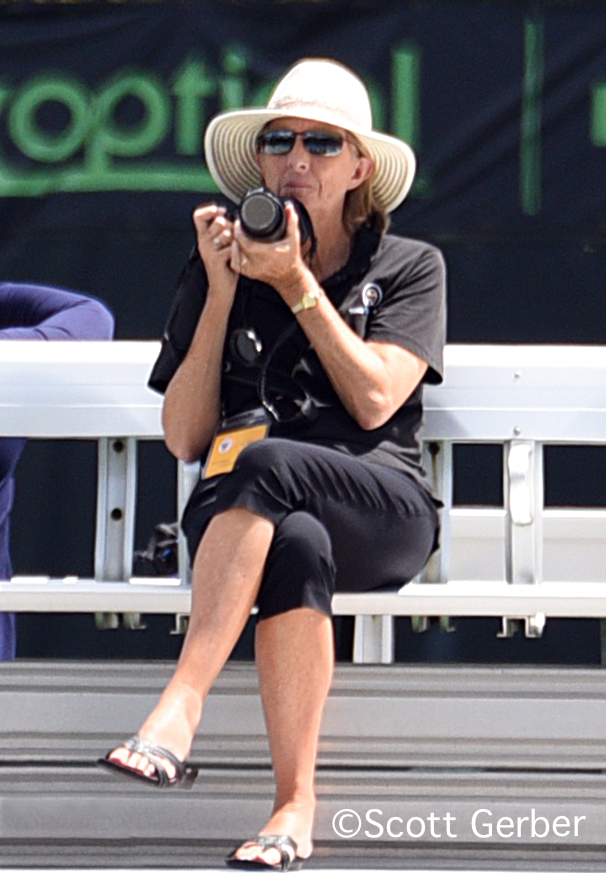The second day of round robin play at the ITF World Tennis Tour Junior Finals in Chengdu China, didn't produce much separation among the 16 players. Spain's Rafael Jodar, the US Open boys champion, and Wimbledon finalist Mees Rottgering both won today, securing their spots in the semifinals. They will play each other Friday for the top spot in Group A.
All four boys in Group B are 1-1, so tomorrow's matches will determine which two advance from that group.
Top seed Emerson Jones of Australia is the only girl undefeated after two matches; she will face Wakana Sonobe of Japan in the third and final round robin match in Group A, and will advance if she wins that match. If Jones loses to Sonobe and Vandromme beats Vergara, who is the only girl yet to win a match, all three will be 2-1, so the semifinalists will be decided by sets and games won.
As with the boys, all girls in Group B are 1-1, so the winners tomorrow will reach the semifinals.
Boys results, Thursday October 17
Group A
Rafael Jodar[1](ESP) d. Hayden Jones[7](AUS) 6-4, 7-6(4)
Mees Rottgering[3](NED) d. Jan Kumstat[5](CZE) 3-6, 6-3, 6-4
Group B
Maxim Mrva[4](CZE) d. Luca Preda[2](ROU) 6-3, 7-6(8)
Charlie Robertson[6](GBR) d. Jangjun Kim[8](KOR) 6-3, 7-6(5)
Girls results, Thursday October 17
Group A
Emerson Jones[1](AUS) d. Antonia Vergara Rivera[8](CHI) 6-2, 6-3
Jeline Vandromme[6](BEL) d. Wakana Sonobe[4](JPN) 7-6(5), 6-1
Group B
Tyra Grant[2](USA) d. Kristina Penickova[7](USA) 6-4, 6-2
Laura Samson[3](CZE) d. Mika Stojsavljevic[5](GBR) 6-4, 6-2
The order of play for Friday is below. Links to live streaming on the ITF YouTube Channel and live scoring can be found
here.
The quarterfinals are set at the three USTA Pro Circuit and two ITF World Tennis Tour events in North America, with current collegians advancing in all five.
At the
W100 in Macon Georgia, Georgia senior Dasha Vidmanova continues her impressive play the past four months, reaching the quarterfinals as a qualifier, as she did last week at the W75 in Edmond Oklahoma. The 21-year-old from the Czech Republic defeated No. 8 seed Anastasia Tikhonova of Russia 6-0, 7-5, and will face No. 2 seed and WTA Top 100 player Anna Blinkova of Russia in Friday's quarterfinals.
Former Georgia All-American Lea Ma, a wild card this week, is also having a good run this fall. The 23-year-old beat yet another Georgia alum, No. 3 seed and WTA No. 87 Maria Carle of Argentina 6-3, 6-1 for her first WTA Top 100 victory.
At the Challenger, Arizona State senior Murphy Cassone, who is taking the fall off, qualified and advanced to the quarterfinals with a 6-2, 6-4 win over No. 2 seed Patrick Kypson(Texas A&M) on Wednesday. Cassone, who saved five match points in his 3-6, 7-6(4), 7-6(11) second round win over Ryan Seggerman(Princeton, UNC), will play No. 6 seed Alexis Galarneau(NC State) of Canada in Friday's quarterfinals. Another American qualifier, Govind Nanda(UCLA), has also advanced to the quarterfinals, beating No. 8 seed James Trotter(Ohio State) of Japan 3-6, 6-4, 6-2. He will face top seed Maks Kasnikowski of Poland in the quarterfinals.
The other two Americans in the Macon quarterfinals are Ann Li[3] and wild card Lauren Davis.
At the women's tournament in Calgary, LSU freshman Cadence Brace, who received a wild card, defeated Julie Belgraver of France 7-5, 6-2 to reach the quarterfinals, where she'll play fellow 19-year-old Canadian Kayla Cross. Two American qualifiers, Anna Rogers(NC State) and Fiona Crawley(UNC), have also reached the quarterfinals. Rogers faces Stacy Fung(Washington) of Canada; Crawley plays top seed Tatjana Maria of Germany.
Ohio State sophomore Aidan Kim, a wild card entry, defeated Texas A&M senior Giulio Perego 6-4, 6-3 to advance to the quarterfinals, where he'll play top seed Toby Kodat, the only non-collegian remaining.
In the bottom quarterfinal, two current collegians will face off. Stefan Dostanic, who will be competing for Wake Forest next year after 4/5 years at USC, will face Texas senior Pierre-Yves Bailly. Dostanic defeated No. 2 seed Aidan McHugh of Great Britain 7-6(5), 6-4 and Bailly beat No. 6 seed Jacob Brumm 7-5, 6-3.
Pan Am J300 champion Jack Kennedy earned his first ATP point yesterday with a win over fellow wild card Ethan Silva(Texas A&M), but he lost to Tadeus Paroulek(TCU, Baylor) 6-4, 6-2 today.
Garrett Johns[3] and Keshav Chopra(Georgia Tech) are the third and fourth American quarterfinalists.
Unsurprisingly, two current Demon Deacons are through to the quarterfinals at the men's
$15,000 USTA Pro Circuit tournament in Winston-Salem, along with one alum. After the No. 1 and No. 2 seeds were beaten Wednesday, with lucky loser Daniel Milavsky, a senior at Harvard, taking out Will Grant(Florida) and qualifier Connor Bruce(Dayton) eliminating Tristan McCormick(Notre Dame, Georgia), only one seed has advanced to the quarterfinals: No. 3 seed Victor Lilov. Lilov, the only non-collegian in the quarterfinals, defeated Cooper Woestendick 6-3, 4-6, 6-4 and will face another Cooper in the quarterfinals, Duke sophomore Williams. Williams is joined by teammate Pedro Rodenas, who will play wild card Matthew Thomas, a recent Wake Forest graduate. Wake Forest sophomore Luca Pow, a wild card is through, as is Wake junior DK Suresh. Suresh faces Milavsky in the quarterfinals.
The
Les Petits As USA Playoffs will conclude Friday in Miami, but after today's quarterfinals, the four boys and four girls who will represent the United States at the tournament in January 2025 have been determined.
The girls semifinalists are Allison Wang, Emery Combs, Tanvi Pandey and Daniela Del Mastro.
The boys semifinalists are Smyan Thuta, Anthony Kirchner, Tristan Ascenzo and Daniel Gardality.
I haven't been able to find any draws or results, but scores were provided for today's quarterfinals via tweets. The boys results tweet is
here and the girls results tweet is
here.


















